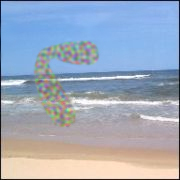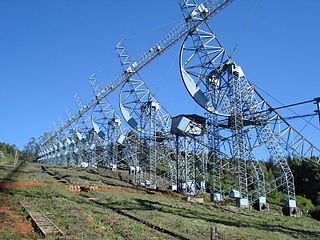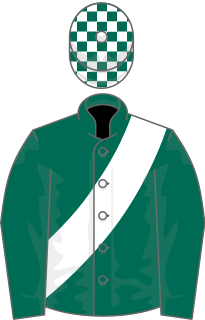Twinkling, or scintillation, is a generic term for variations in apparent brightness or position of a distant luminous object viewed through a medium. If the object lies outside the Earth's atmosphere, as in the case of stars and planets, the phenomenon is termed astronomical scintillation; within the atmosphere, the phenomenon is termed terrestrial scintillation. As one of the three principal factors governing astronomical seeing, atmospheric twinkling is defined as variations in illuminance only.

A scintillation counter is an instrument for detecting and measuring ionizing radiation by using the excitation effect of incident radiation on a scintillating material, and detecting the resultant light pulses.

Astronomical seeing refers to the amount of apparent blurring and twinkling of astronomical objects like stars due to turbulent mixing in the atmosphere of Earth, causing variations of the optical refractive index. The seeing conditions on a given night at a given location describe how much Earth's atmosphere perturbs the images of stars as seen through a telescope.

A scintillator is a material that exhibits scintillation, the property of luminescence, when excited by ionizing radiation. Luminescent materials, when struck by an incoming particle, absorb its energy and scintillate. Sometimes, the excited state is metastable, so the relaxation back down from the excited state to lower states is delayed : the process then corresponds to either one of two phenomena, depending on the type of transition and hence the wavelength of the emitted optical photon: delayed fluorescence or phosphorescence, also called after-glow.

A scintillometer is a scientific device used to measure small fluctuations of the refractive index of air caused by variations in temperature, humidity, and pressure. It consists of an optical or radio wave transmitter and a receiver at opposite ends of an atmospheric propagation path. The receiver detects and evaluates the intensity fluctuations of the transmitted signal, called scintillation.
Scintillation is a flash of light produced in a transparent material by the passage of a particle. See scintillator and scintillation counter for practical applications.
The Bulk Richardson Number (BRN) is an approximation of the Gradient Richardson number. The BRN is a dimensionless ratio in meteorology related to the consumption of turbulence divided by the shear production of turbulence. It is used to show dynamic stability and the formation of turbulence.
The Liquid Scintillator Neutrino Detector (LSND) was a scintillation counter at Los Alamos National Laboratory that measured the number of neutrinos being produced by an accelerator neutrino source. The LSND project was created to look for evidence of neutrino oscillation, and its results conflict with the standard model expectation of only three neutrino flavors, when considered in the context of other solar and atmospheric neutrino oscillation experiments. Cosmological data bound the mass of the sterile neutrino to ms < 0.26eV (0.44eV) at 95% (99.9%) confidence limit, excluding at high significance the sterile neutrino hypothesis as an explanation of the LSND anomaly. The controversial LSND result was tested by the MiniBooNE experiment at Fermilab, which refuted a simple 2-neutrino oscillation interpretation of the LSND result.
David L. Fried is a scientist, best known for his contributions to optics. Fried described what has come to be known as Fried's seeing diameter, or r0. The seeing diameter is effectively a limiting aperture due to atmospheric turbulence, and is found either empirically or statistically. The seeing diameter limits optical resolution. Note that it is a diameter, not a radius, even though r is used as the variable.

Neutron detection is the effective detection of neutrons entering a well-positioned detector. There are two key aspects to effective neutron detection: hardware and software. Detection hardware refers to the kind of neutron detector used and to the electronics used in the detection setup. Further, the hardware setup also defines key experimental parameters, such as source-detector distance, solid angle and detector shielding. Detection software consists of analysis tools that perform tasks such as graphical analysis to measure the number and energies of neutrons striking the detector.

Starfire Optical Range is a United States Air Force research laboratory on the Kirtland Air Force Base in Albuquerque, New Mexico. Its primary duty, according to the official website, is to "develop and demonstrate optical wavefront control technologies." The range is a secure lab facility and is a division of the Directed Energy Directorate of the Air Force Research Laboratory.

Scintillating scotoma, also called visual migraine, is a common visual aura preceding migraine and was first described by 19th-century physician Hubert Airy (1838–1903). It may precede a migraine headache, but can also occur acephalgically. It is often confused with retinal migraine, which originates in the eyeball or socket.
Gadolinium oxysulfide (Gd2O2S), also called gadolinium sulfoxylate, GOS or Gadox, is an inorganic compound, a mixed oxide-sulfide of gadolinium. Its CAS number is 12339-07-0.
In continuum mechanics, wave turbulence is a set of nonlinear waves deviated far from thermal equilibrium. Such a state is usually accompanied by dissipation. It is either decaying turbulence or requires an external source of energy to sustain it. Examples are waves on a fluid surface excited by winds or ships, and waves in plasma excited by electromagnetic waves etc.

The Ooty Radio Telescope is located in Muthorai near Ootacamund (Ooty), south India. It is part of the National Centre for Radio Astrophysics (NCRA) of the well known Tata Institute of Fundamental Research (TIFR) which is funded by the Government of India through the Department of atomic energy. The Ooty Radio Telescope (ORT) is a 530-metre (1,740 ft) long and 30-metre (98 ft) cylindrical parabolic antenna. It operates at a frequency of 326.5 MHz with a maximum bandwidth of 15 MHz at the front-end.
In astronomy, interplanetary scintillation refers to random fluctuations in the intensity of radio waves of celestial origin, on the timescale of a few seconds. It is analogous to the twinkling one sees looking at stars in the sky at night, but in the radio part of the electromagnetic spectrum rather than the visible one. Interplanetary scintillation is the result of radio waves traveling through fluctuations in the density of the electron and protons that make up the solar wind.
Mikhail Aleksandrovich Rytov is a Russian professional football player.

Scintillate was a British Thoroughbred racehorse and broodmare best known for winning the classic Oaks Stakes in 1979. She showed promising form as a two-year-old although she failed to win in three races. After recording her first win in the Sandleford Priory Stakes in the following spring she won the Oaks as a 20/1 outsider. She ran poorly in two subsequent races and was retired to brood where she had limited success as a broodmare.
Rytov or Rõtov is a Slavic masculine surname, its feminine counterpart is Rytova or Rõtova. It may refer to








